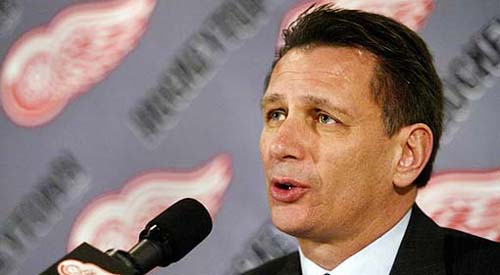
Noting the disparity amongst the NHL’s general managers
Of all the positions within the front office of a professional hockey team, the general manager receives the most credit for a successful season, but the praise doesn’t come without the risk of bearing the majority of criticism when things end poorly.
While all GMs are bound to make at least a few critical mistakes during their tenure, a select few have distinguished themselves from the rest of pack through the moves that they’ve made in the past.
Dipping into the free agent market and making smart signings, executing shrewd trades and grabbing gems in the latter rounds of the Entry Draft are all key components of a successful general manager.
In the case of Nashville Predators’ GM David Poile, though, individual triumph hasn’t exactly brought upon abundant success on the ice. Though the Predators haven’t advanced past the second round of the playoffs, he has managed to assemble a consistently competitive, inexpensive squad.
Red Wings brainchild Ken Holland, a 14-year veteran at the position, has helped transform the Motor City’s NHL franchise into Hockey Town while capturing three Stanley Cups – the most recent coming in 2008.
Arguably his most important mandate is his drafting philosophy. Fifteen of the squad’s 22 roster players are original draftees, including the likes of Pavel Datsyuk (sixth-round pick in 1998), Henrik Zetterberg (seventh round in 1999), Tomas Holmstrom (10th round in 1994) and Nicklas Lidstrom (third round in 1989).
[php snippet=1]
Holland and his staff have proven high picks aren’t necessary when constructing a championship-caliber hockey club. To put that into perspective, the Wings only have two first-round picks on their roster that they drafted. Meanwhile, the Florida Panthers, who haven’t seen the post-season since 2000, have three original first-round picks in their lineup.
Another characteristic of Holland’s game plan is searching for reclamation projects through free agency and trades.
Holland has an eye for digging up steals who were once tabbed as future top-six forwards or even top-four defenseman but failed to live up to heightened expectations. Where would the Wings be without Danny Cleary, Patrick Eaves or Drew Miller? He foresaw potential in each of them and identified their natural skill, despite poor results early on in their careers.
Look around the NHL and realize the number of former Wings player playing prominent roles with new teams. The list includes Canucks forwards Mikael Samuelsson and Ville Leino, who recently signed a long-term deal with the Buffalo Sabres, among others.
What makes the Red Wings so unique is their continuous flow of talent infused into the organization.
Pavel Datsyuk played below Steve Yzerman on the depth chart during the early years of his career before evolving into the star that he is today. Knowing Holland, there is another center, possibly Valterri Filppula, ready to step up to eventually succeed Datsyuk.
Holland prides himself on drafting for talent and patiently allowing prospects to develop before taking on key roles for the big club. He built the roster for the long haul and, while his methods are fairly simple, other GMs continue to envy his ability to construct successful teams.
If you compare Holland’s philosophy to that of Ottawa Senators GM Bryan Murray, the differences in style are noticeable. It’s reasonable to assume all managers have a slightly varied way of doing things, but Murray has dropped the ball on numerous occasions yet still retains his title with the team.
Although the Senators have participated in the playoffs in four of the last six years, the team has gone downhill since losing to Anaheim in the 2007 Stanley Cup Final. The Senators have employed five head coaches since Murray permanently moved up to the front office in 2007.
Players have left town, too – most notably Dany Heatley, who demanded a trade, first refusing to go to Edmonton before landing in San Jose with the Sharks.
In an effort to create a winning environment, Murray instituted a five-year rebuilding plan to create a promising future. However, of the 24 selections Murray has made in the past four drafts, only two — Erik Karlsson and Zack Smith — have played more than 10 games in the NHL.
Aside from Jared Cowen, there aren’t many promising prospects in the system that were selected in the 2010 Draft or earlier.
Murray has also made several miscalculations, including the Heatley trade. The Senators received Milan Michalek, a borderline first-liner better suited for second line duties, and Jonathan Cheechoo, who is no longer with the team, and a second-round pick that was eventually flipped to the New York Islanders. Heatley has gone on to score 39 and 26 goals respectively in two seasons with the Sharks before a 2011 trade sent him to Minnesota.
Both Holland and Murray are experienced managers but it’s abundantly clear the former has developed a team built for long-term success. Murray, on the other hand, has struggled to put the right pieces together in Ottawa to compete consistently.
It’s that ability to compete consistently that can be the difference between a general manager accepting praise from their team’s fans, and another shouldering all the blame.
[php snippet=1]

